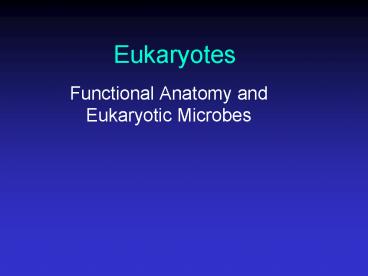Eukaryotes - PowerPoint PPT Presentation
1 / 38
Title: Eukaryotes
1
Eukaryotes
- Functional Anatomy and Eukaryotic Microbes
2
Eukaryotes
- DNA in nucleus, surrounded by membrane
- DNA in several chromosomes
- DNA associated with histones and nonhistone
proteins - Other organelles include endoplasmic reticulum,
Golgi, lysosomes, mitochondria, chloroplasts
3
Eukaryotes
- Cell walls chemically simple (none in animal
cells) - Usually divide by mitosis
- 10-100mm in diameter
- Algae, fungi, protozoa
- Animal and plant cells
4
Evolution of Eukaryotes
- First living cells were prokaryotes
- Endosymbiotic theory
- Organelles inside eukaryotic cells arose from
engulfed prokaryotic cells - Mitochondria and chloroplasts have DNA that
resembles prokaryotic DNA - Ancestors of mitochondria were O2-requiring
bacteria - Ancestors of chloroplasts were photosynthetic
bacteria
5
Emergence of Eukaryotic Cells
6
There exist Contemporary Endosymbionts
- Photosynthetic cyanobacteria (pink) inside
flagellated protozoan Cyanophora
7
Eukaryotic Cell Structures
8
External Structures to Know
- Flagellum
- Cilia
- Glycocalyx
- Cell Wall (fungi)
- Plasma membrane
9
Eukaryotic Flagella
92 arrangement of microtubules in- side a
flagellum
10
Glycocalyx
- Complex multi-sugar polysaccharide
- Plus fibers, capsule or slime layer
11
Cell Walls
- Algae cellulose, pectin, mannans, SiO2,
CaCO3 - Fungi chitin (poly NAG)
- Yeasts glucan and mannan
- Protozoa pellicle instead of cell wall
12
Internal Structures to Know
- Nucleus
- Endoplasmic reticulum / ribosomes
- Golgi apparatus
- Lysosome
- Mitochondria
- Chloroplasts
- Notice all the complex internal membranes!
13
Nucleus
14
Rough Endoplasmic Reticulum
15
Smooth Endoplasmic Reticulum / Golgi
16
Lysosomes
17
Lysosomes
18
Mitochondria
19
Chloroplasts
20
Eukaryotic Microbes
- Fungi
- Protists
- Algae
- Protozoa
- Helminths (multicellular animals, worms, not
really considered microbes)
21
Fungi
22
Fungi
- Largest living beings
- Michigan fungus extended across 40 acres, est.
weight 10 tons - Hyphae (hypha) are long filaments
- Spores germinate to form new fungus
- Can reproduce sexually or asexually
- Very important ecologically the degraders
23
Fungi
- Yeasts are unicellular others are multicellular
- Most are saprophytic
- Beneficial fungi
- decompose dead plants
- symbiotically help plants absorb water and
nutrients - are farmed by ants for food
- are eaten by humans
- produce foods and medicines
24
Pathogenic Fungi
- Fungal diseases are mycoses
- Cutaneous mycoses
- Fungi have keratinase degrade keratin on skin,
nails and hair - Systemic Mycoses
- Spread throughout the body
25
Pathogenic Fungi
- Examples ringworm, athletes foot
26
Pathogenic Fungi
- Systemic mycoses
- Usually caused by soil fungi
- Special problems in immunocompromised hosts
- Example Valley Fever
- Coccidioides immitis
27
Protists Algae and Protozoa
- Algae photosynthetic protists
- Aquatic
- Rarely pathogenic, if ever!
- Primary medical threat is from neurotoxins
28
A Pathogenic Algae Pfiesteria piscicida
- A pathogenic Dinoflagellate
- Dinoflagellates known for red tides
- Inhalation causes neurological, skin, eye,
respiratory and gastrointestinal symptoms
29
Lichens Symbiosis Between Fungus and Alga
30
Protozoa
- 65,000 species!
- Single-celled
- Most are non-pathogenic and free-living (water)
- Complex life cycles
- Protective capsule is called a cyst
31
Protozoan Morphology
32
A Pathogenic Flagellated Protozoa
- Giardia lamblia giardiasis
- infects small intestines
33
A Pathogenic Flagellated Protozoa
- Trypanosoma cruzi
- Chagas Disease infects nervous system and heart
- carried by kissing bugs
- 16-18 million infections, 50,000 deaths / year
34
Helminths
Multicellular macroscopic animals
35
Pathogenic Helminths
- Flukes
- Tapeworms
- Hook worms
- Pin Worms
36
What You Should Know
- Similarities and differences between prokaryotic
and eukaryotic cells - Location and function of all structures discussed
in class
37
What You Should Know
- Morphology of eukaryotic microbes
- unicellular or multicellular
- beneficial uses
- example pathogens
38
What You Should Know
- Types of eukaryotic microbes
- fungi (most macroscopic)
- algae (some macroscopic)
- lichens (macroscopic)
- protozoa (unicellular)
- helminths (macroscopic)































